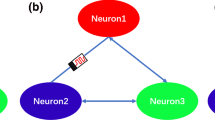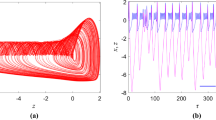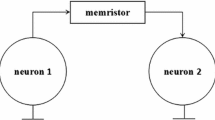Abstract
The fluctuation of intracellular and extracellular ion concentration induces the variation of membrane potential, and also complex distribution of electromagnetic field is generated. Furthermore, the membrane potential can be modulated by time-varying electromagnetic field. Therefore, magnetic flux is proposed to model the effect of electromagnetic induction in case of complex electrical activities of cell, and memristor is used to connect the coupling between membrane potential and magnetic flux. Based on the improved neuron model with electromagnetic induction being considered, the bidirectional coupling-induced synchronization behaviors between two coupled neurons are investigated on Spice tool and also printed circuit board. It is found that electromagnetic induction is helpful for discharge of neurons under positive feedback coupling, while electromagnetic induction is necessary to enhance synchronization behaviors of coupled neurons under negative feedback coupling. The frequency analysis on isolate neuron confirms that the frequency spectrum is enlarged under electromagnetic induction, and self-induction effect is detected. These experimental results can be helpful for further dynamical analysis on synchronization of neuronal network subjected to electromagnetic radiation.








Similar content being viewed by others
References
Hodgkin, A.L., Huxley, A.F.: A quantitative description of membrane current and its application to conduction and excitation in nerve. J. Physiol. 117, 500–544 (1952)
Ader, C., Schneider, R., Hornig, S., et al.: A structural link between inactivation and block of a K\(^{+}\) channel. Nat. Struct. Molec. Biol. 15, 605–612 (2008)
Fleidervish, I.A., Libman, L., Katz, E., et al.: Endogenous polyamines regulate cortical neuronal excitability by blocking voltage-gated Na\(^{+}\) channels. PNAS 105, 18994–18999 (2008)
Gong, Y.B., Hao, Y.H., Xie, Y.H.: Channel block-optimized spiking activity of Hodgkin-Huxley neurons on random networks. Phys. A 389, 349–357 (2010)
Liu, S.B., Wu, Y., Li, J.J., et al.: The dynamic behavior of spiral waves in stochastic Hodgkin-Huxley neuronal networks with ion channel blocks. Nonlinear Dyn. 73, 1055–1063 (2013)
Ozer, M., Perc, M., Uzuntarla, M.: Controlling the spontaneous spiking regularity via channel blocking on Newman-Watts networks of Hodgkin-Huxley neurons. EPL 86, 40008 (2009)
Wang, B.Y., Gong, Y.B.: Effects of channel noise on synchronization transitions in delayed scale-free network of stochastic Hodgkin-Huxley neurons. Chin. Phys. B 24, 0118702 (2014)
Sun, X.J., Shi, X.: Effects of channel blocks on the spiking regularity in clustered neuronal networks. Sci. China Technol. Sci. 57, 884–897 (2014)
Huang, Y.D., Li, X., Shuai, J.W.: Langevin approach with rescaled noise for stochastic channel dynamics in Hodgkin-Huxley neurons. Chin. Phys. B 24, 120501 (2015)
Qiu, K., Tang, J., Ma, J., et al.: Controlling intracellular Ca\(^{2+}\) spiral waves by the local agonist in the cell membrane. Chin. Phys. B 19, 030508 (2010)
Hindmarsh, J.L., Rose, R.M.: A model of the nerve impulse using two first-order differential equations. Nature 296, 162–164 (1982)
Herz, A.V.M., Gollisch, T., Machens, C.K., et al.: Modeling single-neuron dynamics and computations: a balance of detail and abstraction. Science 314, 80–85 (2006)
Izhikevich, E.M.: Which model to use for cortical spiking neurons? IEEE Trans. Neural Netw. 15, 1063–1070 (2004)
Gu, H.G., Pan, B.B.: A four-dimensional neuronal model to describe the complex nonlinear dynamics observed in the firing patterns of a sciatic nerve chronic constriction injury model. Nonlinear Dyn. 81, 2107–2126 (2015)
Ibarz, B., Casado, J.M., Sanjuán, M.A.F.: Map-based models in neuronal dynamics. Phys. Rep. 501, 1–74 (2011)
Wang, C.N., He, Y.J., Ma, J., et al.: Parameters estimation, mixed synchronization, and antisynchronization in Chaotic Systems. Complexity 20, 64–73 (2014)
Ma, J., Xu, Y., Wang, C.N., et al.: Pattern selection and self-organization induced by random boundary initial values in a neuronal network. Phys. A 461, 586–594 (2016)
Song, X.L., Wang, C.N., Ma, J., et al.: Collapse of ordered spatial pattern in neuronal network. Phys. A 451, 95–112 (2016)
Ma, J., Tang, J.: A review for dynamics of collective behaviors of network of neurons. Sci. China Technol. Sci. 58, 2038–2045 (2015)
Ma, J., Xu, J.: An introduction and guidance for neurodynamics. Sci. Bull. 60, 1969–1971 (2015)
Wang, H.T., Chen, Y.: Firing dynamics of an autaptic neuron. Chin. Phys. B 24, 0128709 (2015)
Song, X.L., Wang, C.N., Ma, J., et al.: Transition of electric activity of neurons induced by chemical and electric autapses. Sci. China Technol. Sci. 58, 1007–1014 (2015)
Yilmaz, E., Baysal, V., Ozer, M., et al.: Autaptic pacemaker mediated propagation of weak rhythmic activity across small-world neuronal networks. Phys. A 444, 538–546 (2016)
Herrmann, C.S., Klaus, A.: Autapse turns neuron into oscillator. Int. J. Bifurc. Chaos 14, 623–633 (2004)
Guo, D.Q., Chen, M.M., Perc, M., et al.: Firing regulation of fast-spiking interneurons by autaptic inhibition. EPL 114, 30001 (2016)
Ren, G.D., Wu, G., Ma, J., et al.: Simulation of electric activity of neuron by setting up a reliable neuronal circuit driven by electric autapse. Acta Phys. Sin. 64, 058702 (2015)
Ma, J., Song, X.L., Jin, W.Y., et al.: Autapse-induced synchronization in a coupled neuronal network. Chaos Solitons Fract. 80, 31–38 (2015)
Ma, J., Qin, H.X., Song, X.L., et al.: Pattern selection in neuronal network driven by electric autapses with diversity in time delays. Int. J. Mod. Phys. B 29, 1450239 (2015)
Qin, H.X., Wu, Y., Wang, C.N., et al.: Emitting waves from defects in network with autapses. Commun. Nonlinear Sci. Numer. Simulat. 23(1), 164–174 (2015)
Yi, G.S., Wang, J., Tsang, K.M., et al.: Spike-frequency adaptation of a two compartment neuron modulated by extracellular electric fields. Biol. Cybern. 109, 287–306 (2015)
Yi, G.S., Wang, J., Han, C.X., et al.: Spiking patterns of a minimal neuron to ELF sinusoidal electric field. Appl. Math. Model 36, 3673–3684 (2012)
Akiyama, H., Shimizu, Y., Miyakawa, H., et al.: Extracellular DC electric fields induce nonuniform membrane polarization in rat hippocampal CA1 pyramidal neurons. Brain Res. 1383, 22–35 (2011)
Li, J.J., Liu, S.B., Liu, W.M., et al.: Suppression of firing activities in neuron and neurons of network induced by electromagnetic radiation. Nonlinear Dyn. 83, 801–810 (2016)
Lv, M., Ma, J.: Model of electrical activity in a neuron under magnetic flow effect. Nonlinear Dyn. 85, 1479–1490 (2016)
Lv, M., Ma, J.: Multiple modes of electrical activities in a new neuron model under electromagnetic radiation. Neurocomputing 205, 375–381 (2016)
Li, Q.D., Tang, S., Zeng, H.Z., et al.: On hyperchaos in a small memristive neural network. Nonlinear Dyn. 78, 1087–1099 (2014)
Pham, V.T., Jafari, S., Vaidyanathan, S., et al.: A novel memristive neural network with hidden attractors and its circuitry implementation. Sci. China Technol. Sci. 59, 358–363 (2016)
Cafagna, D., Grassi, G.: On the simplest fractional-order memristor-based chaotic system. Nonlinear Dyn. 70, 1185–1197 (2012)
Yuan, F., Wang, G.Y., Wang, X.Y.: Dynamical characteristics of an HP memristor based on an equivalent circuit model in a chaotic oscillator. Chin. Phys. B 24, 060506 (2015)
Ma, J., Chen, Z.Q., Wang, Z.L., et al.: A four-wing hyper-chaotic attractor generated from a 4-D memristive system with a line equilibrium. Nonlinear Dyn. 81, 1275–1288 (2015)
Chen, M., Li, M.Y., Yu, Q., et al.: Dynamics of self-excited attractors and hidden attractors in generalized memristor-based Chua’s circuit. Nonlinear Dyn. 81, 215–226 (2015)
Sabarathinam, S., Volos, C.K., Thamilmaran, K.: Implementation and study of the nonlinear dynamics of a memristor-based duffing oscillator. Nonlinear Dyn. (2016). doi:10.1007/s11071-016-3022-8
Acknowledgements
This work is supported by National Natural Science Foundation of China under Grant Nos. 11365014 and 11372122 and also supported by the Gansu National Science of Foundation under Grant No. 1506RJZA095.
Author information
Authors and Affiliations
Corresponding author
Rights and permissions
About this article
Cite this article
Ren, G., Xu, Y. & Wang, C. Synchronization behavior of coupled neuron circuits composed of memristors. Nonlinear Dyn 88, 893–901 (2017). https://doi.org/10.1007/s11071-016-3283-2
Received:
Accepted:
Published:
Issue Date:
DOI: https://doi.org/10.1007/s11071-016-3283-2




